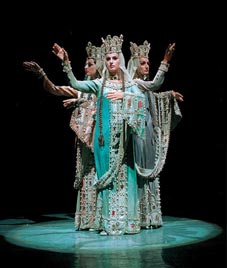More Georgian dances
By Gvantsa Gabekhadze
Friday, May 21

Khonga and Simdi both have their roots in Ossetia, a region in Northern Georgia. They have much in common but also differ significantly from each other. The costumes in both dances are distinguished by their long sleeves. In addition, the headwear of both women and men is exceptionally high. The movements in both dances are similar, but in Khonga men dance on points, which is particularly difficult but is a beautiful sight.
Khonga is performed by only a few dancers and is characterised by the grace and softness of its movements. On the other hand, Simdi is danced by a number of couples. The beauty of Simdi is in the strict graphic outline of the dance, the contrast between black and white costumes, the softness of movements, the strictness of line formations and the harmony created by all of the above.
Women have always played a significant role in Georgia’s history, as is perfectly shown by the dance Samaia. This is performed by three women and is considered to date from pagan times. However today’s Samaia is a representation of King Tamar and her glory. King Tamar is described in many sources as Queen of Georgia, but she was considered to be the king of the United Kingdom of Georgia in 12th-13th centuries and was the first female king in Georgia’s history. There are only four frescos that bear the much-revered image of King Tamar and Simon Virsaladze based the costumes of Samaia on the King’s clothing in these frescos.
The dance conveys the idea of a sort of King Tamar trinity: it represents her as a young princess, a wise mother and a powerful king. All these three images are united in one harmonious picture. Moreover, the simple but graceful movements recreate the atmosphere of beauty, glory and power which surrounded the king’s reign.
